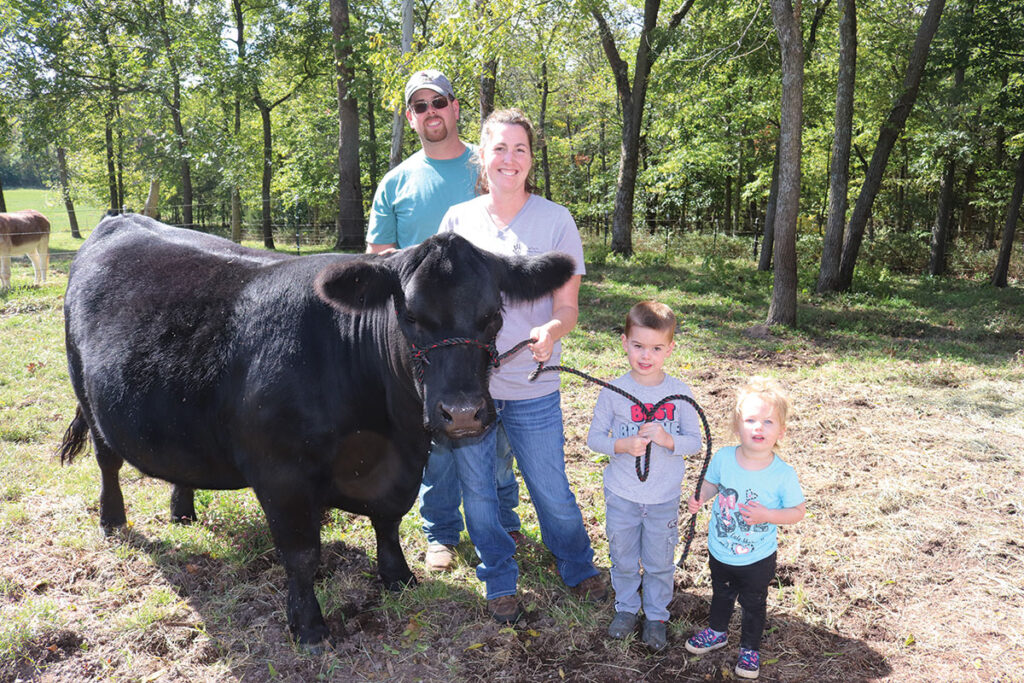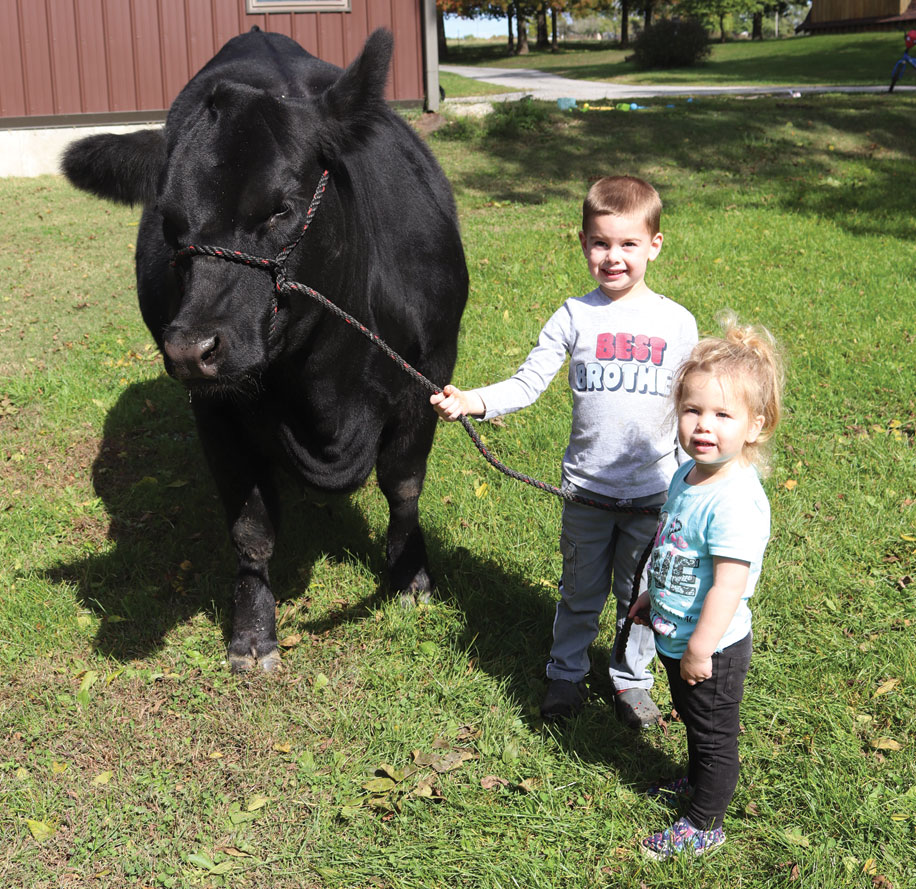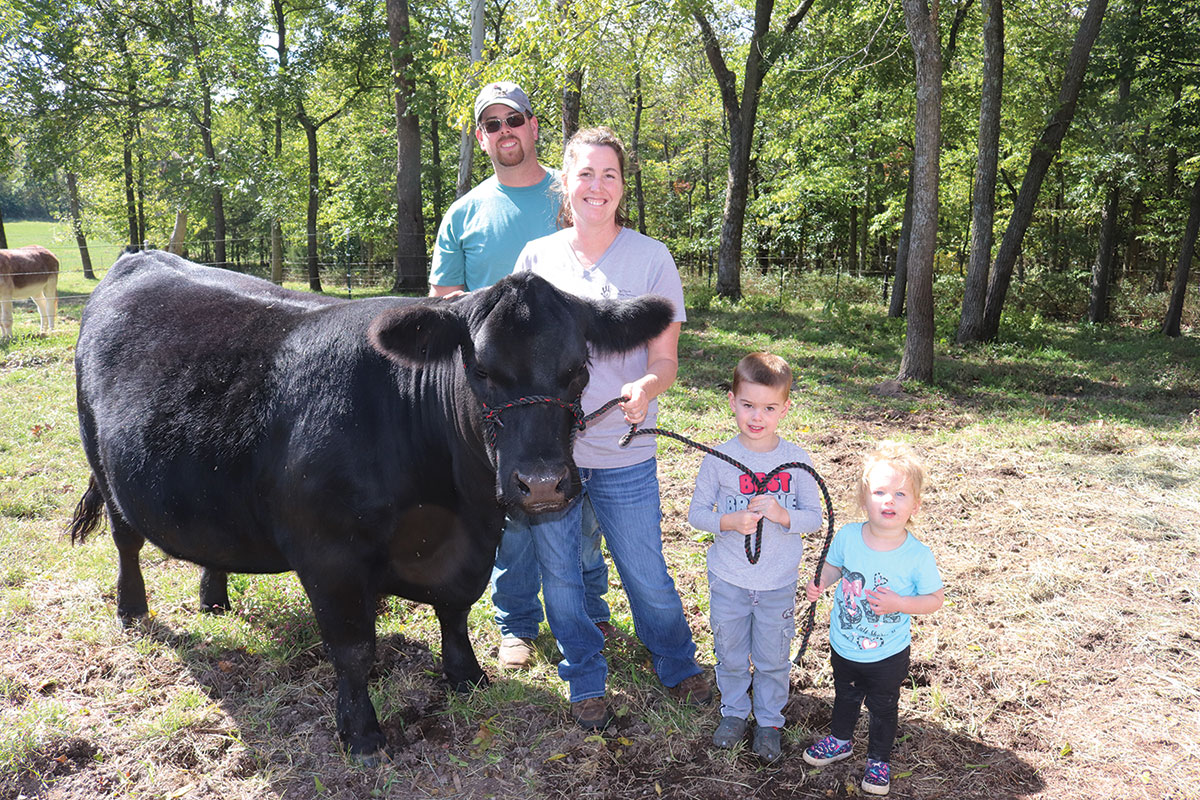
Caleb and Tara Minor switched from commercial cattle to registered Limousin
STRAFFORD, MO. – Caleb Minor grew up surrounded by fields and pastures, but his family didn’t raise cattle.
“My grandpa had some cattle when I was young, then he rented the place out,” Caleb recalled. “When I went to high school and got into ag class, I had to have a project. I always liked cows, and I told Dad we could run them on Grandpa’s place. He bought me two cow/calf pairs at a cow sale. He said I had to keep it all the way through; I couldn’t bail out. I kept some heifers back and got bigger.”
Caleb purchased 80 acres from his grandparents’ 200-acre farm and then the farm across the road and began growing his cattle operation.
Today, Caleb, his wife Tara and young children, Gabe and Reagan, have a little more than 100 head of Limousin cattle.
“I started getting some Limis in 2008, and we added registered in about 2016,” Caleb said. “We are to the point now where we can start running our own operation. We ran the commercial cattle for so long, then it came to the day when we were like, it’s time to move on. Raising registered animals gets in your blood. It’s an addiction once you get started because you want this and this; you want more cows, more land for your cows, and more equipment.”
“We had the kids and wanted them to get involved in doing the show thing and get them into that ag world,” Tara, who is from Maryland and had no prior experience with cattle, added.
Since moving to a registered herd, the Minors have focused on producing quality, eye-appealing females for the pasture and the show ring.
Producing show heifers was not originally part of the plan. However, as the Minors began showing, they sold animals to youth exhibitors and enjoyed watching the cattle and the young producers develop.
“I love seeing the kids and how happy they are,” Caleb said.
“I like to do well for ourselves, but I’m there cheering for the kids,” Tara said. “We might be in the same class in the open show, but I’m cheering for them.”
Because they strive to produce top-quality females, the Minors are very selective.
“We cull pretty hard,” Caleb said. “We might have 40, 50 or 60 calves a year, but cull down to eight or 10 of the very best.”
Culled animals are sold at market, regardless of breeding or registration status.
“If I don’t want it on my farm, I’m not going to sell it as a breeding animal,” Tara said.
Caleb added that the mature herd is also closely culled for failure to raise a quality calf, feet problems, or other issues that limit their viability to the operation.
“We have some that are 16, 18, 20 years old,” Caleb said. “They have been good cows, so it’s not that we’re culling out cows at 5 years old. When they get that old, you start to worry something will happen, but they are proven recips.”
Most of the breeding is via IVF and embryo transfer. About 60 to 70 percent of the females at Minor Limousin receive an embryo first, followed up with AI or a clean-up bull.
“Our clean-up bulls are purebred Limis, so we can still end up with a show calf or a calf that puts on weight for the sale barn,” Tara said.
Their “main” donor is the first show heifer they ever purchased, Fiona. They have six females they flush, but Fiona and two others are flushed every two weeks.
“We have flushed Fiona nine or 10 times this year, and every time we flush her, we have a different bull. If you use different bulls, you aren’t’ flooded with one mating,” Caleb said. “You can do a conventional flush and get 15 eggs, but they are all the same. We try to keep moving forward. We try to use a lot of our own donors, but we do buy some flushes here and there. It’s about doing what you can to try and putting out your best. It’s taken us a while to get there, but over the last couple of years, with the showing and getting out there, people can see what we have.”
Caleb expects to place 40 to 50 embryos this year.

“It’s a gamble,” he said. “Out of 50 calves, you might have five, or you might get lucky and have 30 to 35. Those embryo females are the best cows we have. If all your cows were elite, buying an elite bull and throwing him on them would be easy. You have to take your best cows and breed them to elite bulls to keep moving things around and moving forward. You move forward quicker if you can breed to the best bulls. I didn’t want to get into the embryo side, but after seeing how fast you can get results, it’s better for us.”
Most of the Minor herd is fall calving, with a few spring calves expected, but there are calves being born most of the year.
“Sometimes we will put in fresh, low-grade embryos,” Caleb said, adding those embryos are more successful if placed immediately. “All bets are off then with calving.”
Minor Limousin selects its genetics based on eye appeal, growth rates, and milk production.
“We want our milk to be in the upper 20s and yearling weight 120s to 130s,” Caleb said. “That makes big, stout cows with a lot of milk. Also, people got a bad taste in their mouths for Limis years ago because they were crazy. The breed has worked on that in a big way, and that’s a big thing for us, especially with the kids; they have to be calm.”
Developing bulls is not an area the Minors wish to focus on, but they have developed a bull battery, offering semen from four sires.
Bulls might not be a mainline for the Minors, but a bull they bred recently claimed the reserve champion spot at the American Royal Limousin Show in Kansas City, Mo.
Because of the expense of an embryo calf, Caleb said it’s sometimes hard to cull from the calf crop, but their quest for the best cattle possible decides for them.
“We realize pretty quick that you aren’t going to get anywhere with mediocre stuff,” he said. “We don’t keep a lot of our own stuff because the best stuff sells quickly. Everything is for sale, but we sell bred heifers, so we hold back some.”
“We want quality over quantity,” Tara added.
The family has purebred, fullbloods, percentage and LimFlex genetics they continue to build upon.
“The Limi pulls in the good of other breeds and takes out the bad,” Caleb said. “I want to shoot for 50 percent Limi and on up. If it’s a good cow, we might go a little lower but stay on the upper end. The lower percentage we go, the less they stay here.”
“When you drop that percentage, you tend to lose what makes a Limi a Limi: the milk, docility and growth,” Tara added.
In March, Minor Limousin held its first online sale, offering a group of elite females.
“We’ve sold in association and local sales, but our own sale was a little nerve-racking,” Tara said, adding they plan to have a sale each March.
Caleb and Tara see their participation in cattle shows as a marketing tool for their breeding program.
“Raising cattle and showing cattle can be two different worlds, and we’re trying to combine them both,” Tara said. “We want cattle that look good and can be competitive, but the ultimate goal is it needs to perform out in the pasture. They all have a job to do, and if you have a cow that can’t do their job, what’s the point in having it? They have to perform.”
Caleb added their top donor cow was not a class-topping show heifer, but she did well. Her prodigy, however, has outperformed her.
“You can make a pretty cow, but if you can take a good cow and breed her for certain things, you’re going to make a better cow,” Caleb said. “She’s been an easy building block for us.”
The couple they never plan to close the herd, adding new genetic each year.
“You want to keep moving forward,” Caleb said. “We buy two or three flushes just to see. If you always stay with the same genetics, you will breed the same cattle. You need something else.”







